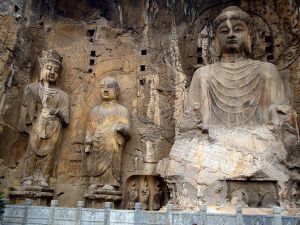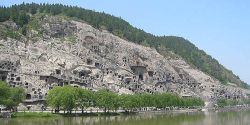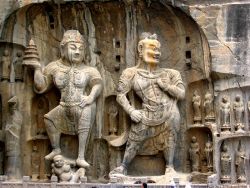Longmen Grottoes
| Longmen Grottoes* | |
|---|---|
| UNESCO World Heritage Site | |

| |
| State Party | |
| Type | Cultural |
| Criteria | i, ii, iii |
| Reference | 1003 |
| Region** | Asia-Pacific |
| Inscription history | |
| Inscription | 2000 (24th Session) |
| * Name as inscribed on World Heritage List. ** Region as classified by UNESCO. | |
The Longmen Grottoes (ch. 龍門石窟/ 龙门石窟, lóngmén shíkū; lit. Dragon's Gate Grottoes) or Longmen Caves are located 12 km south of present day Luoyang in Henan province, China. The grottoes, which overwhelmingly depict Buddhist subjects, are densely dotted along the two mountains: Xiangshan (to the east) and Longmenshan (to the west). The Yi River flows northward between them. For this reason, the area used to be called Yique (The Gate of the Yi River). From north to south, the distance covered by grottoes is about one km. Along with the Mogao Caves and Yungang Grottoes, the Longmen Grottoes are one of the three most famous ancient sculptural sites in China.
Statistics
According to the Longmen Caves Research Institute, there are 2345 caves and niches, 2800 inscriptions, 43 pagodas and over 100,000 Buddhist images at the site. 30% of the caves date from the Northern Wei Dynasty, 60% from the Tang Dynasty, and caves from other periods less than 10%. It is the most impressive collection of Chinese art from these dynasties, and, dating from 316 to 907 C.E., represents the zenith of stone carving in China.[1]
History
During the Warring States Period, the general Bai Qi of Qin (state) once defeated the allied forces of Han (state) and Wei (state) at the site.
Construction of the grottoes themselves began in CE 493.
The area was inscribed on the UNESCO World Heritage List in November 2000. According to the inscription the Longmen Grottoes are an illustration of "...the perfection of a long-established art form which was to play a highly significant role in the cultural evolution of this region of Asia."[1]
Individual grottoes by dynasty completed
Northern Wei
- Guyang Cave
- Middle Binyang Cave (140)
- Lotus-flower Cave
- Weizi Cave
- Huangfugong Cave
Sui
- South Binyang Cave (159)
Tang
- Fengxiansi
- 10,000 Buddha Cave
- Hidden Stream Temple Cave (20)
- Kanjingsi
- Dawanwufo Cave
- North Binyang Cave (104)
Visiting
The Longmen area is open to the public, and although the grottoes cannot be entered most of the artwork can be seen from the exterior. Standard tickets are 80 RMB. Half price tickets (40 RMB) are available to students.
Notes
- ↑ 1.0 1.1 Longmen Grottoes. UNESCO. Retrieved 2007-09-06.
ReferencesISBN links support NWE through referral fees
| |||||||
External Links
Credits
New World Encyclopedia writers and editors rewrote and completed the Wikipedia article in accordance with New World Encyclopedia standards. This article abides by terms of the Creative Commons CC-by-sa 3.0 License (CC-by-sa), which may be used and disseminated with proper attribution. Credit is due under the terms of this license that can reference both the New World Encyclopedia contributors and the selfless volunteer contributors of the Wikimedia Foundation. To cite this article click here for a list of acceptable citing formats.The history of earlier contributions by wikipedians is accessible to researchers here:
The history of this article since it was imported to New World Encyclopedia:
Note: Some restrictions may apply to use of individual images which are separately licensed.



